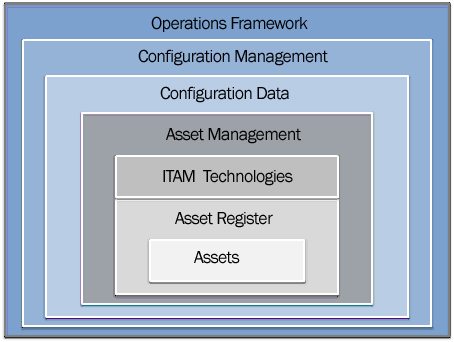ITAM: A Prerequisite for Building a CMDB (Part 4/6) – “Why Building a CMDB is Challenging”

Asset and Configuration Management Partnership
This article series has been contributed by Peter Salfi at Provance.
In this series Peter explains why an Asset Registry, created within an IT Asset Management program, comprised of the appropriate mix of people, process and technology, is often an overlooked prerequisite to creating a CMDB.
It describes a less painful approach to creating a reliable and accurate CMDB that allows organizations to realize a high return on their investment in time, effort and expense.
- PART 1 – Introduction – “Houston, We Have A Problem!”
- PART 2 – The Link between ITAM and ITSM
- PART 3 – 4 Reasons Why ITAM is a Prerequisite for a CMDB
- PART 4 – Why Building a CMDB is challenging
- PART 5 – Summary of Comparisons – ITSM vs. ITAM
- PART 6 – Conclusion – “Back to the Apollo 13 Story”
Part Four – Why Building a CMDB is Challenging
The need for a CMDB was emphasized with the introduction of ITIL. ITIL makes several fundamental assumptions:
- That organizations have access to, and processes in place to collect and manage all the required asset information;
- That they know the operational status of their assets; and
- That they have all this information organized and maintained in a comprehensive, centralized and up-to-date database.
Lack of such an Asset Registry that is presumed to exist is the primary reason why the vision of a CMDB that ITIL promotes has become more of a mirage than a reality. This is the reason why establishing a usable CMDB is time consuming, expensive and difficult to achieve. Without fully understanding each dot, from procurement to disposal, it is impossible to achieve the ITIL objective of connecting the dots.
Failing to first invest in an IT Asset Management program supported by the appropriate IT Asset Management technologies to establish a consolidated and accurate Asset Registry makes an already difficult task essentially impossible. Without these prerequisites in place, CMDBs as they are defined and intended to be used by ITIL will be few and far between.
It is important to recognize that the IT Asset Management and Configuration Management programs and their participants are different and distinct. They do not exist for the same purpose or share the same objective. IT Asset Management mainly supports the business by providing financial and contractual management of assets. It is concerned with what dots you have, where they are, what they do, how much they cost, how they are used, who owns them, when they expire, when they need to be renewed or replaced, and how they were disposed, etcetera.
Configuration Management supports IT operations by focusing on how the dots are connected and work together to form an operational service. It is therefore critical to put in place the appropriate people, processes and technologies to support the attainment of these separate yet inextricably linked mandates.
Given this link between Asset Management and Configuration Management:
- How can Configuration Management be done without first establishing an IT Asset Management program?
- How can IT services be defined without an accurate understanding of the underlying assets, including what is procured and received, what is owned, allocated, installed and utilized and how they are contractually governed?
- How can the Service Desk minimize the adverse effects of disruptions (incidents) without an effective CMDB that provides accurate and timely asset detail?
- How can IT Operations, Procurement, Finance, Receiving and Contract Management optimize the return on IT investments without the visibility and control enabled by a complete and comprehensive Asset Registry supported by an IT Asset Management program and IT Asset Management technologies?
In other words:
How can you connect the dots without knowing what dots you have, where the dots are, what the dots do, how the dots are used, and who’s responsible for the dots?
Read Part Five: ‘Summary of Comparisons – ITSM vs. ITAM‘.
This article series has been contributed by Peter Salfi. To find out more about Provance IT Asset Management for Microsoft System Center visit Provance.
About Martin Thompson
Martin is also the founder of ITAM Forum, a not-for-profit trade body for the ITAM industry created to raise the profile of the profession and bring an organisational certification to market. On a voluntary basis Martin is a contributor to ISO WG21 which develops the ITAM International Standard ISO/IEC 19770.
He is also the author of the book "Practical ITAM - The essential guide for IT Asset Managers", a book that describes how to get started and make a difference in the field of IT Asset Management. In addition, Martin developed the PITAM training course and certification.
Prior to founding the ITAM Review in 2008 Martin worked for Centennial Software (Ivanti), Silicon Graphics, CA Technologies and Computer 2000 (Tech Data).
When not working, Martin likes to Ski, Hike, Motorbike and spend time with his young family.
Connect with Martin on LinkedIn.


It is interesting mentioned by many vendors are Windows centric.
A
proper baseline from an ITAM perspective MUST include all of the IT infrastructure. This will include network switches, routers, servers
(regardless of platform), printers, etc… Why you ask?
Well without these devices you will not get services (applications) or email
or access to iny information in your company or the outside world without all of the infrastructure that makes up the fabric of the
company.
Once you baseline your infrastructure then look at how it changes over time without any planning or change management.
So when looking at ITAM and technologies that support ITAM and the CMDB keep in mind that during your internet search you are actually
touching each and every one of those devices along the way.
Gary
Hurrah, that’s what I was searching for, what a information! present
here at this blog, thanks admin of this web site.